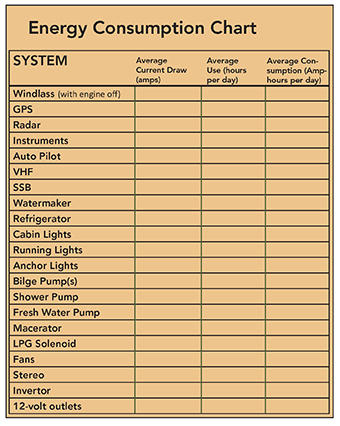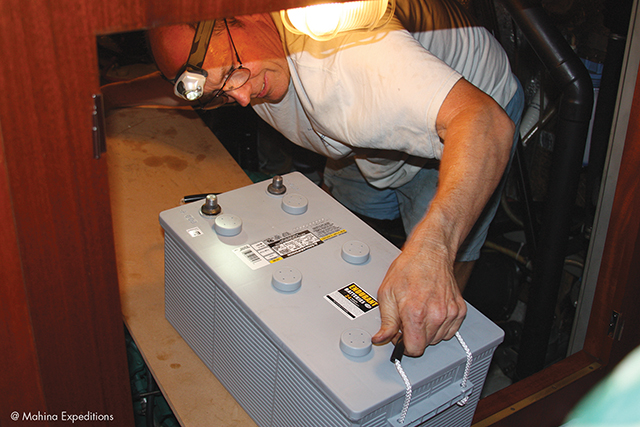As Ben Franklin might say, an amp-hour saved is an amp-hour earned (published November 2013)
Modern cruising boats tend to be well equipped with refrigeration, marine electronics, computers, home entertainment systems, and energy gobbling options like electric winches, watermakers and more. If you are not careful, the daily onboard energy bill can easily exceed 100 amp-hours. Meeting your energy needs requires plenty of charging capacity and an ample battery bank. But, you also need to cut energy waste wherever possible. Here are some basic tips to help you reduce your daily energy use.
REFRIGERATION
If you are running an electric fridge, then this can easily be the single largest consumer of electricity on board accounting for 30 to 60 amp hours a day. Insulation or the lack of it can be a huge problem as the cold air seeps steadily from the box. Reinsulating a fridge box is a big job, but there are easy fixes that will vastly improve the compressor’s efficiency. First, use closed cell foam blocks to fill open gaps in the fridge so you are effectively cooling smaller spaces in the box and using less energy.
Check the seals around the fridge door and lids to make sure the box is well sealed. If the box has a drain into the bilge, install a petcock in the hose to prevent cold air from flowing out. In hot weather, place a towel over the lid as extra insulation.
Check the electrical voltage at the compressor. If it falls below 12 volts, the compressor will lose efficiency and will barely cool the box. You may have a long wire run from the batteries to the main breaker panel and then to the fridge, and the wire gauge may not be of the optimum size; so, you could have 13 volts at the batteries and 11.5 at the compressor. A solution is to up the wire gauge and run the wires directly to the compressor via its own circuit breaker. You can increase the volts delivered to the compressor by one or more and increase its efficiency dramatically.
LIGHTS
Incandescent lights are standard equipment on most cruising boats, yet for people living aboard and often sailing through the night, these old fashioned bulbs can be serious energy gluttons that will devour the amps in the battery bank at a rapid rate. The solution is to replace these relics with modern bulbs. But you don’t have to go crazy with every light on board.
A good place to start is by replacing the masthead tri-color and anchor light with an LED combination so when you are sailing through the night or anchored out, you won’t have flat batteries in the morning. You can leave the deck level running lights and steaming light incandescent since you often have the engine running when you have these switched on.
Belowdecks, replace incandescent lights over the chart table, in the galley and heads with dual red-white fluorescent lights so you can use the efficient white lights in normal situations and the red lights when sailing at night.
LEDs are expensive, so you may choose to replace only those incandescents that you use the most with these amazingly efficient bulbs. These could include the saloon overhead lights, the reading lights above the bunks and lights you may have in the cockpit.
INVERTER POWER
We all need to charge our phones, tablets and laptops while on the boat. These can all be charged with 12 volts through the boat’s system with car style charging units. But this is not the most efficient way to charge these devices and the low voltage does not give them the same deep charge as 110 volts.
A large high quality inverter will make your life aboard better in many ways, not the least because you will be able to use a blender and run a small vacuum cleaner. But, a powerful inverter will also charge your mobile devices with a deep and long lasting charge.
AUTOPILOT LORE
Autopilots have become so reliable and efficient that most cruisers rely on them for almost all the helming of their boats. Yet, on a long day’s run or while on passage, the power drain from the autopilot, particularly in stronger breezes and rolling seas, can be significant. Over a 24 hour period in trade wind strength weather, you can expect the pilot to consume 40 to 80 amp-hours of battery reserves.
The first thing to check is the response level of the autopilot, since most units are designed for powerboats that are charging the batteries all the time. Sailboats need a less active steering mode so the rudder is not turning every time the boat changes course slightly as it moves through the waves and puffs.
The next thing to check is simple sail trim. If you have a lot of weather or lee helm, the autopilot with have to work overtime. Up wind, use the main sheet and traveler to create a very slight weather helm on the wheel before engaging the pilot so the correction will always be a small regular move and not a hunting move. Off the wind, ease the headsail slightly to prevent the boat from rounding up when you surf down a wave.

Energy efficiency afloat is not rocket science, but it can make a huge difference in the life of your battery bank and ultimately your quality of life as a self sufficient cruiser who is not married to battery charging every day.

















